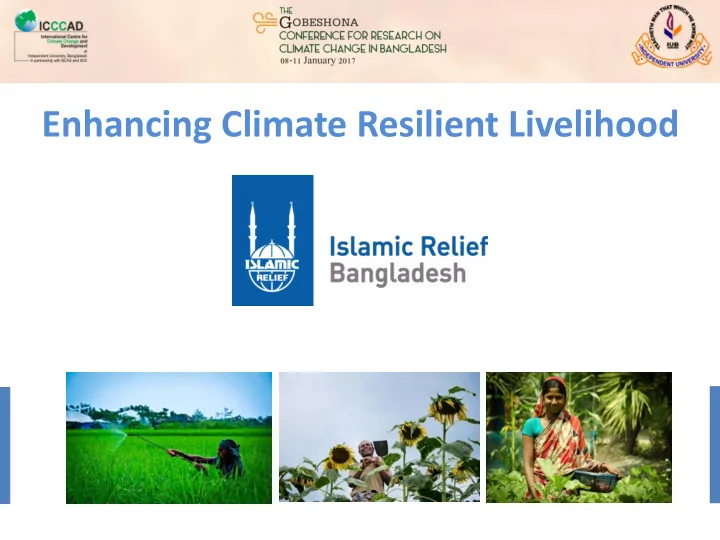

Enhancing Climate Resilient Livelihood
Background Population Need 185 million of BD in Hamper 2030 Climate Impact of Climate Change Causes of Climate Change Flooding Change Salinity in coastal area Deforestation Cyclone Industrialization Drought Crop yield loss Urbanization Loss of biodiversity & adaption GHG & fossil fuel Ozone depletion Radiation Fresh water decline Particulate matters Alter precipitation Land degradation Alter ecosystem Population migration
Causes of Increase Salinity Intrusion in Coastal Belt of Bangladesh Location of the country Sedimentation Sea level rise Cyclone and storm surge Tidal flooding Changes in ground water flow Shrimp cultivation Weak structure of embankment Poor maintenance High evapo-transpiration No scope to flush out of accumulated salts No/less use of organic soil amendments Use of imbalanced fertilizers and pesticides Saline area 20% of the total area and almost 30% of net cultivable area, BD.
Existing Scenario of Agriculture of Koyra and Shyamnagar Drought Salt Agricultural fields- Moderately to highly saline (Dec, 15) Shrimp cultivation Mono-cropped area (T- aman , kharif 2 season) Rabi season (wheat, maize) Fallow in kharif 1 season Salinity & drought are high during kharif 1 season High scarcity of irrigation water No/less use of organic matter Lack of modern technologies for crop production Loss of crops yield Less amount of cattle due to unavailability of forage crops Accompany of poverty and malnutrition Migration to city
Present Cropping Pattern Cropping Season Existing Crops Kharif 2 season: Drier, T -aman (Local, HYV, hotter , rainy (Mid Hybrid) June to mid October) Rabi season: Drier and cooler (Mid October to Wheat, Maize mid March) (Small area) Kharif 1 season: Drier and hotter (Mid March Fallow to mid June) So, single cropped, T- aman, resulting in scarcity of food, nutrition, medication etc.
Common Techniques to Grow Crops during Kharif 1 and Rabi season b. Soil organic & inorganic amendments Cowdung Fertilizers a. Suitable Crop Varieties Poultry manure Calcium Mung bean Compost Potassium Maize Green manure Nitrogen Kharif 1 Jute Vermicompost Minerals Indian spinach Zeolite Swamp cabbage Pumpkin Mustard c. Plant bio-regulators Rabi Barley Gibberellic acid Potato Auxin Sunflower Salicylic acid Jasmonic acid Cytokinin
Objectives To introduce salt tolerant varieties during kharif 1 and Rabi season with changing climate. To improve the livelihood of poor people living in coastal area by increasing cropping intensity through new crop varieties.
Materials and Methdos Team is formed by consultants and researchers Site Selection: -Ramjannagar, Shyamanagar -Maheshwaripur, Koyra During site selection we consulted with Upazilla Chairman Upazilla Nirbahi Officer Upazilla Agriculture Officer Sub Assistant Agriculture Officer Union Parishad Chairman/Councilor/Local Leader
Materials and Methdos Farmers selection • Interest to innovative adaptation Crops Selection • Education • Short duration • Experience • High yielding • Age • • Knowledge and Skills Saline & drought tolerant Plots Selection/Utilities • Beside the road • Close to water source • Avoid wet soil • Land area assessment • Discuss with officials of IRB
Farmers Field Laboratory Crops ( Kharif 1 ) Name of Crop Type of Crop Yield (t/ha) Yield (t/ha) Treated Plot Non-Treated Plot Swamp cabbage (Local) Leafy vegetable 41.5 16.6 Indian spinach (Local) Leafy vegetable 53.2 15.8 Mungbean Pulse crop 1.36 0.52 (BARI Mungbean 5) Maize (Hybrid) Cereal 4.20 1.12 Jute (Deshi) Fibre 2.17 0.68
Farmers Field Laboratory Crops ( Rabi ) Name of Crop FFL Yield Expected National Percentage highest Yield Average Yield Increased Pumpkin 30.0 35 20 50% Mustard 0.95 1.5 0.89 6.74% Barely 2.5 2.2 1.87 33.69 % Potato 20.0 25.0 10.0 100% Sunflower 1.5 1.7 1.0 50 %
On Farm Activities for Climate Resilience Under Farmers Field Laboratory several climate adaptive crops were trailed by 101 farmers and found 82% have been successful. Many a household started practicing bag or sack gardening and sold their produced vegetables at local market. Male and female headed household involved in homestead gardening and succeeded to have their daily meals triply.
Findings After involvement with Farmers Field Laboratory (FFL) About 70% beneficiary has taken family farming as their major occupation; among them 53.4% are females Cropping intensity increased from single to mono- cropping due to cultivation of successful kharif 1 and Rabi crops (Swamp cabbage, Indian spinach, Mungbean, Pumpkin, Barley, Potato) trailed under FFL which ultimately improves their livelihood.
Cont’d The successful crops are scaled up at similar ecological zones in collaboration with BARI, local extension service provider. Beneficiaries showed very interest on continuing the homestead vegetable gardening, among them 85% produced some species of vegetable and improved their nutritional status. Total 330 households practiced bag gardening in the study areas and produced chili, tomato, eggplant, spinach in the sacks.
Messages In coastal area Swamp cabbage, Indian spinach, Mungbean, Maize, Jute are found suitable to face climatic variability such as soil salinity, high temperature and water scarcity and these successful varieties need to be replicated and scaled up. Pumpkin, Mustard, Barley, Potato, Sunflower are considered as rabi season crops in the saline prone area of Satkhira and Khulna district. In considering sustainability, scope of institutionalizing FFL approach, strengthening collaboration and harmonization with extension service interventions need to be explored.
Th Than ank k Yo You
Recommend
More recommend